
Duration: 6h 5m | Video: 1280×720 30fps | Audio: AAC, 48 kHz, 2ch | Size: 1.87 GB
Genre: eLearning | Language: English
Machine Vision, GANs, Deep Reinforcement Learning LiveLessons is an introduction to three of the most exciting topics in Deep Learning today. Modern machine vision involves automated systems outperforming humans on image recognition, object detection, and image segmentation tasks. Generative Adversarial Networks cast two Deep Learning networks against each other in a “forger-detective” relationship, enabling the fabrication of stunning, photorealistic images with flexible, user-specifiable elements. Deep Reinforcement Learning has produced equally surprising advances, including the bulk of the most widely-publicized “artificial intelligence” breakthroughs. Deep RL involves training an “agent” to become adept in given “environments,” enabling algorithms to meet or surpass human-level performance on a diverse range of complex challenges, including Atari video games, the board game Go, and subtle hand-manipulation tasks. Throughout these lessons, essential theory is brought to life with intuitive explanations and interactive, hands-on Jupyter notebook demos. Examples feature Python and straightforward Keras layers in TensorFlow 2, the most popular Deep Learning library.
About the Instructor
Jon Krohn is Chief Data Scientist at the machine learning company untapt. He presents a popular series of deep learning tutorials published by Addison-Wesley and is the author of the bestselling book Deep Learning Illustrated. Jon teaches his deep learning curriculum in-classroom at the New York City Data Science Academy, as well as guest lecturing at Columbia University and New York University. He holds a doctorate in neuroscience from Oxford University and has been publishing on machine learning in leading journals since 2010.
Skill Level
Intermediate
Learn How To
Understand the high-level theory and key language around machine vision, deep reinforcement learning, and generative adversarial networks
Create state-of-the art models for image recognition, object detection, and image segmentation
Architect GANs that create convincing images in the style of human-drawn illustrations
Build deep RL agents that become adept at performing in a wide variety of environments, such as those provided by OpenAI Gym
Run automated experiments for optimizing deep reinforcement learning agent hyperparameters, such as its artificial-neural-network configuration
Appreciate what the current limitations of “artificial intelligence” are and how they may be overcome in the near future
Who Should Take This Course
Perfectly suited to software engineers, data scientists, analysts, and statisticians with an interest in applying Deep Learning to natural language data
Code examples are provided in Python, so familiarity with it or another object-oriented programming language would be helpful
Course Requirements
The author’s Deep Learning with TensorFlow, Keras, and PyTorch LiveLessons, or familiarity with the topics covered in Chapters 5 through 9 of his book Deep Learning Illustrated, are a prerequisite.
Lesson Descriptions
Lesson 1: Orientation
Lesson 1 starts with a quick review of how to run the code in the lessons. It then reviews the foundational deep learning theory that is essential for building machine vision, GANs, and deep reinforcement learning specializations. The lesson wraps up with a sneak peek at the cutting-edge capabilities that will be developed over the course of all five LiveLessons.
Lesson 2: Convolutional Neural Networks for Machine Vision
Lesson 2 introduces convolutional layers. Convolutional layers are first used to create ConvNets in TensorFlow. The lesson then covers the gamut of machine learning applications, including residual networks, image segmentation, object detection, transfer learning, and capsule networks.
Lesson 3: Generative Adversarial Networks for Creativity
Lesson 3 begins with the applications of and essential theory behind generative adversarial networks (GANs). You then are shown the Quick Draw! Game, which is used as a source of hundreds of thousands of hand-drawn images from a single class for a GAN to learn how to imitate. The rest of the lesson is spent developing the intricate code for the three primary components of a GAN: the discriminator network, the generator network, and the adversarial network that pits them against each other.
Lesson 4: Deep Reinforcement Learning
Lesson 4 begins with a definition of deep reinforcement learning, then turns to an overview of its applications. The lesson wraps up with a discussion of the relationship of deep reinforcement learning to artificial intelligence.
Lesson 5: Deep Q-Learning and Beyond
Lesson 5 starts with the Cart-Pole game, which is used in the lesson to train the deep reinforcement learning algorithms. Then it turns to the theory behind deep reinforcement learning as well as deep Q-learning, a popular type of deep reinforcement learning agent.
With this theory under your belt you will be able to understand at an intuitive level the code that you subsequently when you define your own DQN agent and have it excel at the Cart-Pole game. The lesson wraps up by exploring a tool for optimizing deep reinforcement learning agent hyperparameters, introducing agents beyond DQN agents, outlining some possible project ideas, and return to the discussion of artificial intelligence to address the limitations of contemporary deep learning approaches.
Password/解压密码www.tbtos.com
转载请注明:0daytown » Machine Vision, GANs, and Deep Reinforcement Learning